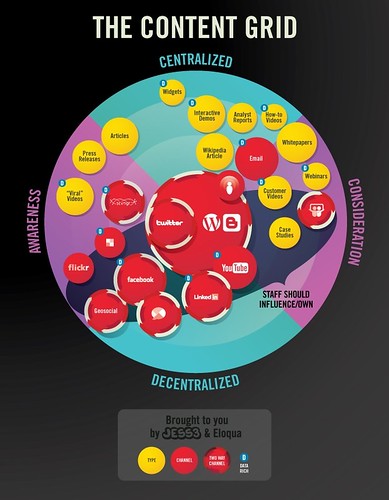Creating Social Media Content
In our previous post, How Will You Speak on Social Media?, we talked about how to communicate on social media by Being a Person. This post we talk about creating social media content.
Content
At the risk of you thinking we’re getting too carried away with numbers of letters, we’d like to mention just one more set, concerning content: Paul Dunay’s list of the Four S’s of Social Media (oddly, in a post entitled The 4 P’s to Social Media Marketing). It pulls ideas from four influential books on online marketing:[1]
- Tell Good Stories — think Unleashing the Idea Virus[2] by Seth Godin
- Make them Sticky — think Made to Stick[3] by Chip and Dan Heath
- Package them to be Shareable — think World Wide Rave[4] by David Meerman Scott
- Launch them using all available Social Media — think Inbound Marketing[5] by Brian Halligan, Dharmesh Shah and David Meerman Scott
Telling stories is what we do all the time, offline. This may take the form of gossipy tale-telling, “Can you believe what she said?” or “Did you hear about what happened to Jim?” or more well-developed yarns like “When we finally stopped the car we realized not only was the engine smoking, but we had two flat tires.”
The best way to begin to engage with your community is to tell stories. Stories humanize us, and can set listeners at ease. But stories are just the beginning. You want to establish a dialog — to get your community involved.
Discussion vs. Dialog
Many people call what happens online a discussion. You’ll see terms like “discussion group” used to describe places online where people congregate to talk. But discussion may not be the best term for the kind of interaction you want to foster. You may want something a bit more intimate.
The physicist David Bohm developed an approach to conversation which he called dialogue. Bohm compared dialogue (derived from Greek words implying “a flow of meaning”) with discussion (derived from Latin words implying, “a shaking apart”).
The former is creative and collaborative, the latter analytical and often competitive. Bohm says:
Dialogue is not discussion, a word that shares its root meaning with ‘percussion’ and ‘concussion,’ both of which involve breaking things up. Nor is it debate. These forms of conversation contain an implicit tendency to point toward a goal, to hammer out an agreement, to try to solve a problem or have one’s opinion prevail.[6]
The following table, from a paper by Richard Seel[7] indicates some of the differences between the dialogue and discussion:
| Dialogue | Discussion |
| Starts with listening | Starts with talking |
| Is about speaking with… | Is about talking to… |
| Focuses on insights | Focuses on differences |
| Is collaborative | Is adversarial |
| Generates ideas | Generates conflicts |
| Encourages reflection | Encourages quick thinking |
| Encourages emergence | Encourages lock in |
Do you notice anything about the characteristics listed in the right column? They all have a lot in common with traditional push marketing — talking to, adversarial, encourages quick thinking, encourages lock in: This pretty aptly describes the modern television commercial.
In your content, and in your community spaces, you’ll want to target the elements in the left column: listening, speaking with, collaborative, generates ideas.
To do so, make sure your content draws the reader in, rather than aims to make your points. Your content should encourage collaboration and idea generation, rather than focusing on differences or being adversarial. Think of your community spaces as your living room, where, as Chris Brogan says, all the chairs face each other, not your lecture hall, where the chairs all face you.
In addition to these qualities, you’ll want your content to be:
|
Type of Content |
What? |
Where? |
| Educational | Service features and benefits | Blogs, Website, Twitter, YouTube |
| Targeted | No spam (unlike broadcast media) | Facebook, LinkedIn, community ads, engage customers where they are online |
| Authentic | Client reviews and recommendations | Website, Blogs, YouTube, real success stories, your real staff! |
| Valuable | “How-To”, Tips & Tricks | YouTube, Website, Blogs, Wikis, Communities — don’t be afraid to entertain |
Creating Social Media Content is the 54th in a series of excerpts from our book, Be a Person: the Social Operating Manual for Enterprises (itself part of a series for different audiences). We’re just past page 180. At this rate it’ll be a long time before we get through all 430 pages, but luckily, if you’re impatient, the book is available in paper form at bit.ly/OrderBeAPerson and you can save $5 using Coupon Code 62YTRFCV
See the previous posts What is Social Media?, Social Sites Defined, Why Social Media? How is Social Media Relevant to Business? First Steps Toward a Social Media Strategy, and Decide What Your Business Will Do About Social Computing, pt. 1
Next up: Creating Social Media Context
[1] Dunay’s The 4 P’s to Social Media Marketing: bit.ly/acF6Eu
[3] Heath’s Made to Stick: amzn.to/bWG5YB
[4] Scott’s World Wide Rave: amzn.to/d9ptf9
[5] Halligan, Shah, and Scott’s Inbound Marketing: amzn.to/9wuYxY
[6] Dialogue – a Proposal by David Bohm: bit.ly/b1uCPT
[7] Story & Conversation in Organisations: A Survey by Richard Seel: bit.ly/dpnj4Z







